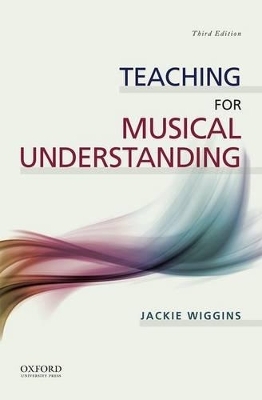
Teaching for Musical Understanding
Oxford University Press Inc (Verlag)
978-0-19-937173-0 (ISBN)
theory applies to music education. The text is deeply grounded in the work of social constructivist theorists and researchers in both education and music education.The third edition takes a
cultural psychology perspective, giving more attention to sociocultural influences and to the roles of learner agency in learning process. It includes in-depth examples of assessment practices in music classrooms, stories "from the trenches," and more extensive use of endnotes and citations.
Jackie Wiggins is Distinguished Professor Emerita of Music Education and former Director of the School of Music, Theatre, and Dance at Oakland University.
* Each chapter ends with selected resources:
Preface:
Acknowledgments:
1. Learning: An Embodied, Constructive Process
Contemporary Understandings About Learning
Understanding as Schema:
Understanding as Metaphor:
Understanding as Image:
Understanding as Embodied:
Implications for Teaching
Contexts for Learning
2. Learning: A Sociocultural, Constructive Process
A Social Constructivist Vision of Learning
Scaffolding:
Learning is a Holistic Process:
Learning is Experiential, Not Necessarily Sequential:
Learning Requires Learner Agency:
Learner Agency and Teacher Power:
A Social Constructivist Music Learning Community
3. Learning Music through Embodied, Constructive Process
Conceptualizing Music
Our Metaphorical Understanding of Music Concepts
Elements or Dimensions of Music?
Metadimensions of Music
Dimensions as Points of Entry: A Doorway In
How do we Construct our Concepts of Music?
Constructing Concepts in Context
Teaching for Musical Understanding
4. Learning Music through Sociocultural, Constructive Process
Teacher Role: Scaffolding Learners
Scaffolding Learners:
Establishing a Supportive Learning Environment:
Finding Out What Learners Know:
Encouraging Expression of Musical Ideas:
Focusing Learner Energy:
Monitoring Learner Understanding and Progress:
Providing a Model of Musicianship:
Learner Roles
A Social Constructivist Music Learning Community
5. Music Learning as Musical Problem Solving
Learning Through Problem Solving
Learning and Teaching Music Through Problem Solving
Planning Musical Problems
What Will Learners Be Learning?
The Musical Context:
Organizing the Experience:
Assessment:
Lesson Planning
Planning the Problem:
6. Performing, Listening and Creating Problems
Performing Problems
Listening Problems
Creating Problems
Composing and Arranging:
Media for Composing:
Musical Dimensions as Points of Entry for Composing:
Organizing Small-Group Composing:
Songwriting:
Improvising:
Dimensions as Points of Entry for Improvising:
Improvising Within Structures:
Music Learners as Creative Musicians:
7. Thinking About Learners in Planning Musical Problems
Entry-level Experiences for Young Learners
Singing:
Moving:
Playing:
Creating:
Listening:
Notating:
Technology:
Nature of Problems for Young Learners
Entry-level Experiences for Older Beginners
Middle-Level Experiences
More Complex Experiences
Sample Lesson and Unit Plans
8. Entry-Level Musical Problems
Lesson 8.1 Identifying and Representing Beat
Lesson 8.2 Identifying and Representing Duration and Pitch
Lesson 8.3 (For Older Beginners) Entry-Level Exploration of Pitch and Duration
Lesson 8.4 Exploring Contour and Direction through Listening
Lesson 8.5 Using a Song to Develop a Class Performance
Lesson 8.6 Experiencing Style
Lesson 8.7 A Musical Conversation
Sample of Student Work:
9. Middle-Level Musical Problems
Lesson 9.1 Experiencing and Creating with Dynamics
Sample of Student Work:
Lesson 9.2 Analyzing and Creating a Melody
Samples of Student Work:
Lesson 9.3 Effects of Tempo Change
Sample of Student Work:
Lesson 9.4 Timbre: Using Alternate Sound Sources
Lesson 9.5 Tonal Center
Lesson 9.6 What Do You Hear?
10. Planning Units of Study
Planning a Unit on Texture
Unit: Texture
Lesson 10.1 Melody and Countermelody:
Lesson 10.2 Representing Texture (Score Reading):
Lesson 10.3 Solo and Ensemble:
Sample Student Work:
Unit: Monothematic Works
Lesson 10.5 Creating Interest through Expressive Qualities:
Qualities:
Samples of Student Work:
Unit: Meter (2-4 Class Sessions)
Lesson 10.6 Identifying Meter (1 Session):
Lesson 10.7 Compose a Piece That Changes Meter:
Unit: Arranging a Round
Lesson 10.8 Learning the Round:
Lesson 10.9 Arranging the Round:
Sample of Student Work:
11. Complex Musical Problems
Unit: Bithematic Forms (Verse and Refrain, ABA Form, etc.) (3-6 Class Sessions)
Lesson 11.1 Hearing Bithematic Form:
Lesson 11.2 Composing in Bithematic Form:
Samples of Student Work:
Lesson 11.3 A More Extended Bithematic Work:
Unit: Harmonic Structure (4 Sessions)
Lesson 11.4 Introducing Tonic and Dominant Harmonies:
Lesson 11.5 Using Tonic and Dominant Harmonies:
Sample of Student Work:
Lesson 11.6 Hearing Tonic, Dominant, and Subdominant Harmonies:
Lesson 11.7 Singing Chordal Harmonies:
Unit: Theme and Variation (6-8 Sessions)
Lesson 11.8 Introducing the Idea of Variation:
Lesson 11.9 Analyzing a Theme and Variation:
Lesson 11.10 Composing Variations on a Theme:
Samples of Student Work:
Unit: The Blues (4-6 Sessions)
Lesson 11.11 Introducing the Blues:
Unit: Variations On A Ground Bass (6-8 Sessions)
Extension:
Sample of Student Work:
12. Connecting to Other Ways of Understanding
Interdisciplinary Learning in K-12 Settings
Interdisciplinary Learning through Process and Conceptual Connections
Process Connections:
Conceptual Connections:
An Arts-infused Curriculum
Pathway:
Characterization:
Point of View:
Stories and Illustrations:
Egyptian Art:
Role of the Individual within a Group:
Wood Sculptures:
Balance:
Daffodils:
Symmetry:
Some Closing Thoughts
Epilogue:
Appendix A: Music for Lessons:
Appendix B: Classroom Materials:
Appendix C: Directions for Games:
Endnotes:
References:
Index:
| Erscheint lt. Verlag | 17.11.2014 |
|---|---|
| Zusatzinfo | Illustrations, unspecified |
| Verlagsort | New York |
| Sprache | englisch |
| Gewicht | 410 g |
| Themenwelt | Kunst / Musik / Theater ► Musik ► Musiktheorie / Musiklehre |
| ISBN-10 | 0-19-937173-3 / 0199371733 |
| ISBN-13 | 978-0-19-937173-0 / 9780199371730 |
| Zustand | Neuware |
| Haben Sie eine Frage zum Produkt? |
aus dem Bereich


